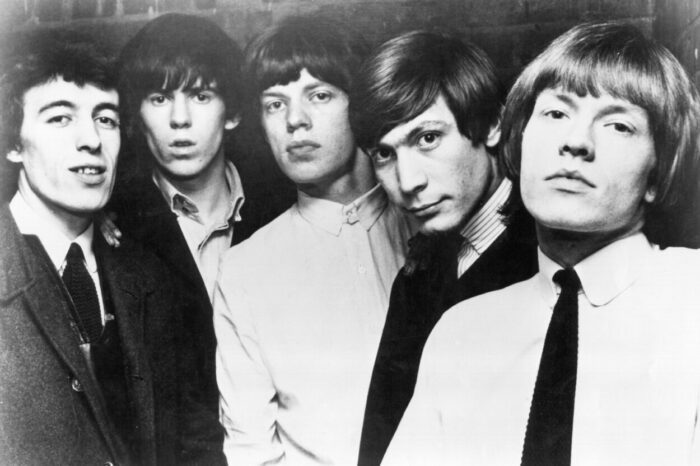Who’d have imagined that here in the late months of 2023, the Rolling Stones, or what remains of them—Mick and Keef and Ronnie Wood, who joined the band in 1975—would still be making new music, to good reviews and chart records at that? Probably not the group’s original lead/rhythm guitarist and founder Brian Jones, whose death rocked the band in 1969 but also converged with the peak of their artistry. Director Nick Broomfield’s new documentary The Stones & Brian Jones focuses exclusively on those early years of the band, from their 1962 formation to Jones’ death, yet somehow manages not to convey convincingly Jones’ many musical contributions to the Stones’ definitive sound.
Broomfield, the director of Leonard & Marianne, Kurt & Courtney, and Biggie & Tupac (note that predilection for compounds and ampersands), reportedly met Brian Jones, by chance, on a train in 1963, at the height of his success. To Broomfield, Brian and the Stones were a major influence, an inspirational band, and the occasion to focus on this period of the band’s success could hardly be overlooked. Those were, of course, exuberant times, full of intergenerational conflict, drug experimentation, musical innovation, and sexual revolution. Sex, drugs, and rock and roll: that was Brian Jones’ life.

Jones was, in the early days of the band, when they were exclusively a blues cover band, its leader and spokesman. It was Jones who placed the advert for a new band and recruited Jagger and Richards. It was Jones who determined the group’s initial musical direction. It was Jones who gave them their enduring name. It was Jones who served as their first business manager and relentlessly booked their first gigs. It was Jones who with Keith Richards developed the band’s signature twin-guitar sound, their intertwining of lead and rhythm parts. It was Jones’ talent as a multi-instrumentalist that allowed the band to branch out beyond their initial amped-up blues covers.

Getty Images. Photo courtesy of Magnolia Pictures.
That all changed.
The band hired a new manager, Andrew Loog Oldham, to increase their visibility. He pressed the members to write original songs, as John Lennon and Paul McCartney were doing for The Beatles, sensing correctly that doing so could lead to a financial gold mine. Jagger and Richards stepped up to do so; Jones did not. Oldham also focused the band’s personality and promotions around its charismatic lead singer Jagger, who did not shy from the spotlight.
These early years, from Jones’ initial leadership to his gradual abdication of it, are sufficiently documented in Broomfield’s documentary. There are letters of Jones’, narrated by Freddie Fox, plus interviews with retired/original Stones bassist Bill Wyman, who served as an historical consultant on the film, and others, including, briefly, Jagger, Richards, Oldman, and several of Jones’ paramours.

The Stones and Brian Jones also features several clips of the band in early live performance, which are a welcome sight, as well as publicity interviews, including one cringeworthy episode of a clueless host interviewing Jones about his songwriting, which the non-writer painfully tries to finesse. Broomfield makes the most of this content, but what seems to me glaring in its omission is the studio music of this period. Like their contemporaries The Beatles, whose explosive career arc the Stones did much to follow, the early to mid-Sixties were a time of nearly exponential musical innovation, and Jones was an integral part of the band’s chart hits and deep tracks both.
You won’t see or hear that, in any degree, in The Stones & Brian Jones. The absence of Jones’ adventurous multi-instrumentalism played a major part in the Stones’ evolution beyond a cover band: he played marimba on “Under My Thumb” and “Out of Time,” organ on “Let’s Spend the Night Together,” recorder on “Ruby Tuesday,” Mellotron on “She’s a Rainbow,” saxophone on “Dandelion,” and sitar on “Paint It Black” and “Street Fighting Man”—to name just a few. Those songs are absent from Broomfield’s film, as is any extended discussion of Jones’ contributions to the band’s evolving aural soundscape, one that was as adventurous as any band’s.
Broomfield focuses more of his analysis of these years less on Jones’ music than on his drug use and love affairs. Jones was, to be fair, from the band’s early days its sex symbol, the member with the most fan mail and female (and probably not a little male) admiration. He was not short on confidence or ego, and he could be, by all reports, condescending, even outright meanspirited in his interactions with others, but he had a sex appeal that played a major part in the band’s popularity. His relationships get far more play here than his music, especially his fiery, abusive affair with Anita Pallenberg, who left him for Richards, an emotional blow from which Jones never seemed to recover.

The strength of The Stones & Brian Jones, then, is in its archival material, the footage of young Jones in the band’s early heyday, the letters to and from him during their success and his downward spiral, the perspectives of others who knew, loved, and betrayed him. When Jones died, no one, it seemed, was surprised: the band hired a replacement, played Hyde Park in tribute, and quickly went on to what many will call the zenith of their artistry, from Let It Bleed and Sticky Fingers to Exile on Main Street and the string of memorable hit singles, beginning with “Gimme Shelter,” that accompanied them.
In 2023, Jones is now a footnote in the Stone’s biography, once a key player in their formation and for a short time their leader, but whose death—the first of several high-profile drug-related rock-star deaths to follow at the end of the decade and the start of the ’70s—sent the band to even greater heights. Broomfield’s documentary, though polished and well-made and featuring a surfeit of new material, is oddly silent on the one thing that truly made Jones’ contributions to the Rolling Stones unique: his multi-instrumentalist talent and his guitar playing that helped shape the band’s signature sound.
Without the music, The Stones & Brian Jones is all sex and drugs, and not much rock and roll.
The Stones & Brian Jones releases theatrically in the U.S. for a One Night Only event Nov. 7, 2023, and on digital and streaming on demand platforms Nov. 17, 2023.



